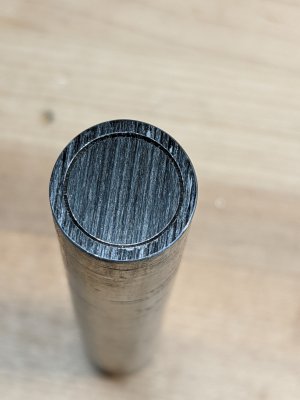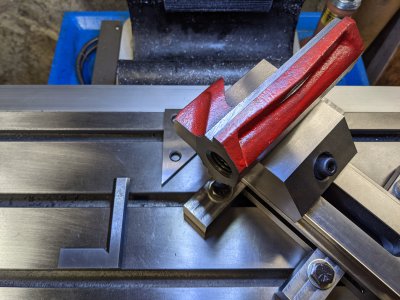- Joined
- Dec 18, 2019
- Messages
- 7,320
After 2 seconds of observation, I realized I could use the toolmakers vise to hold the nut upside down. I then milled flats on the top side so I could hold the nut at 90 degrees. I ran a mill just kissing the flat at the end to smooth that end. Just shaved off 0.001" enough to take off the tool marks. Prior to that I checked that the "flat" was perpendicular to the table. Surprisingly it was pretty good.
Roughly measured the ramp angle, it is very close to 45 degrees, but it is not square to the vertical axis. There's about a 0.04 gap at the top relative to the bottom, as measured with a square referenced to the fixed jaw top. I'd bet in practice this doesn't matter, as the ball takes up the error, but it's annoying.
Next step is to tram the toolmakers vise to 45 degrees so I can take a cut on the ramp to clean it up. I have a 45 degree angle block so that won't be too hard. The milling cutters I have aren't long enough to cut the ramp in one pass. I need almost 1.5" LOC to do it in a single pass.
A bit apprehensive about lapping the pocket. It will be tedious at best. Maybe a single cut spherical burr would be better and faster. As I understand it a single cut is slower and more precise.
Roughly measured the ramp angle, it is very close to 45 degrees, but it is not square to the vertical axis. There's about a 0.04 gap at the top relative to the bottom, as measured with a square referenced to the fixed jaw top. I'd bet in practice this doesn't matter, as the ball takes up the error, but it's annoying.
Next step is to tram the toolmakers vise to 45 degrees so I can take a cut on the ramp to clean it up. I have a 45 degree angle block so that won't be too hard. The milling cutters I have aren't long enough to cut the ramp in one pass. I need almost 1.5" LOC to do it in a single pass.
A bit apprehensive about lapping the pocket. It will be tedious at best. Maybe a single cut spherical burr would be better and faster. As I understand it a single cut is slower and more precise.


